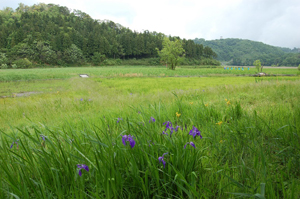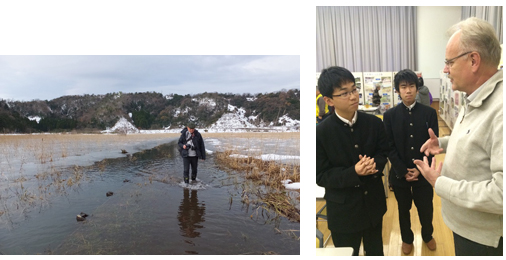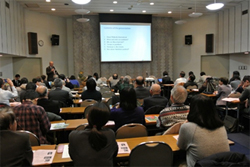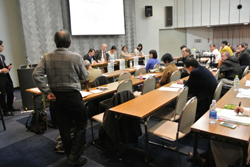22th of Jan,2015
Symposium Report
Consider the institutional problem of Japanese protected area system regarding internationally protected area – through the case of bullet train development project in Nakaikemi Ramsar site
Date: 21st of Dec, 2014 Location: Tokyo, Japan

1. Backgrounds and aim of the symposium
Nakaikemi-shicchi (Tsuruga city, Fukui prefecture) was designated as internationally important wetland under Ramsar Convention in July 2012 due to its unique topographic feature called sac-like waste-filled valley, its rarity of world prominent over 40 meters deep peat layers created over a hundred thousand years, and its abundant biodiversity.
However, just after the designation, the route construction plans for Hokuriku bullet train was released and it passes through the Nakaikemi-shicchi.
(→photo:Nakaikemi Ramsar site in May)
Actually, the first plan for the bullet train was released in March 1996. In January 2002, environmental impact statement based on the plan was released to the public. Later route plan had been changed from the plan in 2002, and newly revised plan was released in August 2012, just after the designation. The new proposed route will pass through Ramsar site much closer to core area than previous plan in 2002.
Environmental survey for impact forecast of the construction has been conducted in accordance with the newly revised route. If the construction were to start and the route were to pass through the Ramsar site, it would marginalize the meaning of internationally protected area. Also, there are Japanese institutional problem of protected area systems in the background. Therefore, we Nature Conservation Society of Japan (NACS-J) held a symposium with local NGOs aimed at raising awareness of the issues on Nakaikemi-shicchi.
2. Guest speaker:Mr. Marcel Silvius
The guest speaker of the symposium was Mr. Marcel Silvius, well known as a researcher of peatland, also the program head of the Wetland International, the one of partner NGO of the Ramsar convention. He had an on-site inspection to the Nakaikemi-shicchi and had interactions with the local government, local NPO and NGOs, local youth to know the “wise use” of this area.

↑Left: On-site inspection in Nakaikemi-Shicchi,Right: Interaction with local youth
3. Symposium

Over 70 people gathered for the symposium include local people from Tsuruga city and Ministry of Environment, even it was held in Tokyo where the problems of Tohoku bullet train and Nakaikemi-shicchi have been known very little. The others guest speakers were Ms. Kaori Tsujita from Wildlife Division, Nature Conservation Bureau, Ministry of the Environment (MoE), Japan, Ms. Chieko Sasaki from the local NPO – Wetland Nakaikemi, who has been working for Nakaikemi -shicchi for 30 years, and Prof. Masahito Yoshida from the University of Tsukuba, also the specialist of protected areas and the chairperson of Japan Committee for IUCN.
(→photo:Scene of the symposium)
Firstly, Mr. Silvius spoke about the importance of peatland from the view of rich biodiversity, carbon accumulation, and historical archives. He expressed the impression of Nakaikemi shicchi that it is rich in biodiversity and many species of dragonflies and plants can be seen. Forty meters of peat layers are one of the deepest peat layers in the world and on-site inspection made him felt the value of it.
Regarding the issues of Hokuriku bullet train, he commented that “To be a Ramsar site means that the government of Japan committed to maintain the ecological character of the area. It also means that Nakaikemi-shicchi is recognized that it has significant value not only for Japan but also humanity. I really hope Japan will deliver on international commitments through the Ramsar Convention, also the Convention of Biological Diversity. Nakaikemi ramsar site set very bad pressure if the area is being disturbed. It would give us the very bad example to the rest of the world. I think even if the environment impact assessment compare the old route and new route, you always have to think the alternatives if there are issues and that handle so important point for the area. I would hope that Japanese system somehow allows this option to look at the other alternatives and do not continue business as usual.”

Secondly, Ms. Tsujita from the MoE introduced about importance of Ramsar site, conservation measure, good-practices of wise use in Japan. Thirdly, Ms. Sasaki from the local NPO talked 30 years activities to overcome some development plans such as construction of a factory complex or a gas storage station.
Lastly, Prof. Yoshida from the University of Tsukuba pointed out some background of institutional problems in Japan.
(→photo:(from the left) Prof. Masahito Yoshida from the University of Tsukuba, Mr. Marcel Silvius from the Wetland International, Interpreter, Ms. Chieko Sasaki from the Wetland Nakaikemi, Ms. Kaori Tsujita from MoE)
-
The Environment Impact Assessment(EIA) act allows the developer to make minor change of development plan after Environment Impact Assessment but developer can decide what “minor” means without third party views. For the case of bullet train, regulation under EIA act says that the route change within the range of 300meters is allowed by operator’s decision.
-
There is no expiring term of environmental assessment data. The result of EIA should be appropriately reflected to the decision including permission to the development but it should be careful that status of biodiversity can be change after a certain period of time. In this case, it took 10 years from last environmental assessment to the start of development.
-
For ensuring conservation status, Ramsar wetlands are designated as National wildlife conservation area under Wildlife Protection and Hunting Law or National/Quasi National Park under the Natural Parks Law in Japan. But activities in Quasi National Parks such like Nakaikemi-shicchi are controlled by prefectural government. That means, nevertheless Nakaikemi-shicchi was designated as international protected area, national government does not have authority for development.
-
Communication between public administrations related with conservation and development are insufficient and there is a lack of transparency and civil participation in the administrative process.
4. Panel discussion
The ideas of the ways to protect Ramsar sites were opened up for discussion with floors. Ms. Sasaki from the local NGO argued that local community should watch the developing projects because there is no announcement about the project. Also pointed out the sectionalism in public administrations was causing problems too.
Mr. Silvius said that there were different ways of dealing with it in different countries but local communities always should have a big voice as to whether or not developing goes on. He also mentioned that “I found it was very strange that the operator could decide to shift the route. To avoid passing through a few houses cannot be the reason to shift the route of bullet train 150meaters inside the Ramsar site, international importance, something has been there for 100,000years, they have species do not occur in anywhere in the world.
I think if it would be happen in the European Union, the court , the third party, qualify the decision whether or not the decision or plan made by government or company. One of the things that not happening here w to allow the local community proposes alternatives to the new route and the old route. There are alternatives what have not been studied. It needs to be discussed.”
In addition, “Wise use” and domestic laws to conserve Ramsar sites have discussed with floors too.
It took 5hours marathon symposium but there were conscious participants and vigorous questioning. The feedbacks from participants were “I could understand the importance of Nakaikemi shicchi”, “Revision or newly establishment of domestic low should be made”, “I wish the alternatives will be made” and “The Ministry of Land, Infrastructure, Transport and Tourism and the operator(Japan Railway Construction, Transport and Technology Agency (JRTT)) should have attended the symposium”.

↑A scene of the panel discussion.







